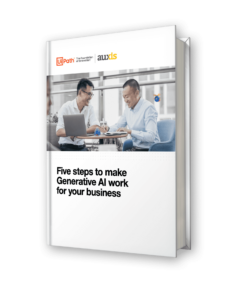Ready or not, the future is digital – and staying competitive in 2023 and beyond means harnessing the power of digital technology to reimagine how your company operates. But disruptive change can be overwhelming – and easily veer off course. A digital transformation roadmap that’s right-sized to your business and goals is key to successfully driving speed, innovation, agility, and lower costs across functions.
Digital transformation is accelerating, with 60% of executives citing it as their most critical growth driver in 2022, PwC states. Future-proofing operations is another top-of-mind concern: nearly 40% of enterprises are leaning into digital investments to emerge from today’s macroeconomic uncertainty in a stronger position than their competitors, according to EY’s CEO Outlook Pulse.
But successful digital transformation involves more than implementing the latest technology – it requires shifting your organizational mindset. It involves rethinking business models and processes to benefit from opportunities created by emerging tech and innovate a new way of work.
While 89% of enterprises have adopted or plan to adopt a digital-first strategy, an alarming 69% of digital transformation initiatives fail to achieve desired outcomes.
Here’s how to create an effective digital transformation roadmap: pinpointing where you are, where you want to go, and the best route for arriving at your destination successfully.
How to create a digital transformation roadmap in 5 smart steps

1. Align leadership behind digital transformation goals.
The possibilities for implementing disruptive technology seem endless: improving customer experiences with better data and analytics, optimizing costs and efficiency by automating manual processes, boosting agility and resiliency by moving key services to the cloud, and so much more. And with digital-first companies 64% more likely to achieve their business goals, it’s no surprise executives are eager to get started.
Here’s the thing: Different teams throughout your organization will have different ideas about areas that require improvement. Aligning leadership behind a strategic plan for impactful transformation is essential to driving the greatest value enterprise-wide.
Seems obvious, right? But too many initiatives fall apart because organizations get lost in the weeds – triggering innovation in silos that stops digital transformation from scaling.
Rushing to solve today’s problems can also lead to wasted investment that threatens executive buy-in. For instance, it makes no sense to automate processes in areas leadership doesn’t see as a long-term focus.
Ongoing support rests on ensuring leadership understands why current processes aren’t working and how your transformation strategy can deliver new levels of performance. Uniting business and technology strategies at the start focuses your journey and helps create a high-level roadmap for how to get there.
2. Let the business lead.
Successful transformation infuses technology into the heart of business strategy. While IT stands as a value co-creator, drawing your digital transformation roadmap with a business mindset ensures you achieve the best results.
With daily experience in the process weeds, business teams know what stands in the way of operational excellence. True digital transformation relies on that expertise to design a better way of work, ensuring technology is deployed strategically and most effectively.
After all, automating a poorly designed process without fixing its underlying flaws simply makes an inefficient process run faster.
A business-led strategy enables a 360-degree view of digital transformation as well – analyzing the broader impact across employees, departments, and other business areas. Understanding where targeted processes fit into your company’s operational profile and strategic goals ensures ROI for each initiative is clear, supported, and appropriate for your organization.
It also ensures change doesn’t cause related processes to break.
3. Assess your current state.
Understanding where you are in your journey is vital to developing a digital transformation roadmap that lays the best path forward. A thorough assessment of your current state engages stakeholders enterprise-wide to identify high-value improvement opportunities that accelerate company goals.
These insights form the jumping-off point for leveraging technology and tools to design more effective and efficient operations.
Future-state process flows should challenge old assumptions, eliminate non-value-added tasks, and redefine team roles to focus on more strategic work. Digital transformation should also assess possibilities for maximizing use of legacy technology; for instance, taking advantage of automation capabilities in your existing ERP system.
Estimating the savings potential of each opportunity compared to your current state creates a digital transformation roadmap strategy, identifying and prioritizing initiatives that maximize impact and returns. You should also assess projects that can start your journey with quick wins, turning skeptics into advocates and spreading enthusiasm company-wide.
4. Sequence your digital transformation roadmap for quick returns.
Breaking your roadmap into manageable sequences sets your journey up for success: setting clear, realistic, and measurable goals with fast ROI. Transformation takes time and delivering frequent chunks of value maintains momentum and support – reinforcing digital transformation as a table-stakes investment in your company’s future.
Thoughtful sequencing can solidify buy-in as well, providing quick, concrete evidence of how digital transformation can directly improve work lives. Sequencing further drives scalability, presenting a natural opportunity to regroup after each phase so teams can learn from successes and make necessary adjustments.
Amidst economic uncertainty, turning large-scale initiatives into a series of smaller projects also supports cost management – enabling enterprises to accelerate innovation growth and achieve quicker returns with less upfront investment. Sequencing keeps transformation journeys focused as well, preventing efforts from falling apart because resources were spread too thin across multiple greenlighted initiatives.
Besides cost considerations, a successfully sequenced roadmap prioritizes initiatives that are strategically important, minimize complexity, and deliver the fastest payback. Plans for legacy systems can also impact sequencing, requiring modernization or replacement before some projects can start.
5. Measure value as your roadmap unfolds.
Proving the value of each initiative is essential for driving your digital transformation roadmap strategy forward, establishing benchmark measures and improvement targets during the design phase. Clearly defined criteria provide the best way to measure success, considering what data will be used, when and who will collect it, analysis method, and more.
Clearly defining, predicting, and tracking value drives continuous improvement that captures the full promise of transformation. It ensures the pace and priority of your digital transformation roadmap remain aligned with your business goals.
Detailed visibility also enables insight-based decision-making as impactful questions arise throughout your journey. That way, you can ensure the right actions are taken, new opportunities are identified, and course corrections are made quickly to maximize your returns.
Finally, continuously quantifying value maintains support, providing insight into key business drivers like cost savings, efficiency gains, and revenue growth. While the most effective KPIs are ultimately linked to specific outcomes and business goals, common metrics include return on digital investments, employee productivity, user experience, digital adoption rate, and investment/costs.

Engaging the right digital transformation partner matters
A well-crafted digital transformation roadmap structures your journey to ensure a successful outcome. But most organizations lack the expertise to define and manage a journey of such magnitude – struggling to fully understand the nature and impact of each change to drive the right course of action.
A Gartner survey of large enterprises found transformation journeys taking twice as long and costing twice as much as expected.
Not surprisingly, increasing the pace of digital transformation ranked as the No. 1 driver for engaging a third-party provider in Deloitte’s 2022 Global Outsourcing Survey. Partnering with a quality digital transformation provider delivers the experience, best practices, and expertise to drive the greatest ROI throughout your journey.
Enterprises that hire nearshore partners beat the IT labor shortage as well by accessing a deep pool of skilled resources in similar time zones – enabling better collaboration and an agile development model. Outsourced teams focused on your initiatives also increase success, negating the inherent risk of complex implementations driven by internal teams busy with many priorities.
Experienced partners come to the table with a proven methodology for assessing and transforming operations, combining business expertise and technical knowledge to achieve operational excellence. They are experts at assessing value vs. complexity vs. cost of improvement opportunities to prioritize your digital transformation roadmap.
They have best-in-class reporting tools to measure results, and they keep up with ever-evolving technologies and strategies to ensure digital transformation delivers the biggest benefits. They also provide strong governance that ensures project deployment happens on time and within budget, obstacles are effectively handled, and business impacts are anticipated and managed.
Embracing foundational change and innovation is not for the faint of heart. The right digital transformation partner keeps your journey strategically on track – crafting and implementing a digital transformation roadmap that drives fast and sustainable transformation.
Want to learn more about reaping the benefits of digital transformation for your business? Schedule a consultation with our digital transformation experts today!


